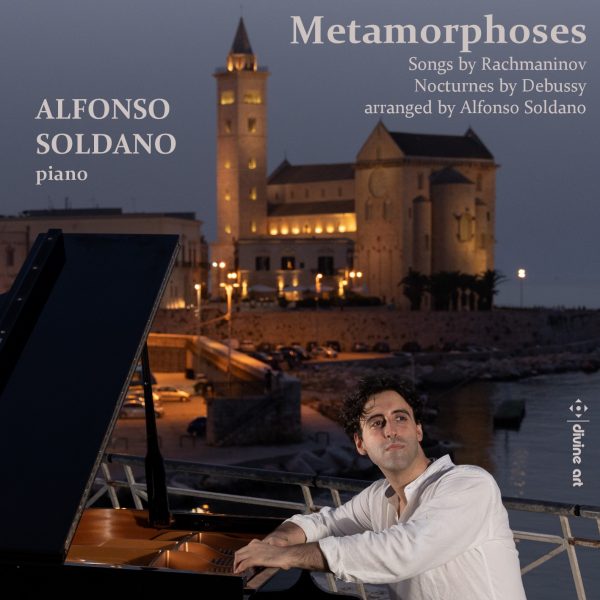Fanfare
NOTE: this review also appeared in American Record Guide.
Alfonso Soldano (b. 1986) plays his own piano solo arrangements of the Rachmaninoff songs and Debussy’s orchestral works. Most of the pieces here exist in one or more other arrangements for piano solo, duet, or two pianos. The shadow of Liszt looms large with song arrangements and orchestral transcriptions that require a true virtuoso technique. The songs, much like Liszt, start out as an almost exact transcriptions of the combined voice and piano parts, and then grow more complex and difficult. Short songs are occasionally extended with an additional verse, and the piano parts that are difficult to begin with are extended far beyond what would be appropriate if played with a singer. There are also key modulations and transpositions that grow out of the virtuosity. The orchestral pieces are transcriptions that follow the original in both key and length. The creative aspect here is how well Soldano builds the complex sounds and voices of a full orchestra using just two hands.
There are 13 widely respected (and very difficult) piano solo arrangements of Rachmaninoffsongs by Earl Wild (but only four of those are also set here by Soldano). Twelve of those appeared back in 1981 and one was added later. Julia Severus’s disc has 21 songs arranged for solo piano by seven different people, including the pianist and the composer himself. Nine of those are also arranged by Soldano here. There are many others, notably Kocsis’s Vocalise, which has been recorded many times. Rachmaninoff’s songs, despite their exceptional qualities, were slow to enter the standard repertoire. My assumption for this is the Russian language and the Cyrillic alphabet. The difficulty of the piano parts challenges the best pianists. Most Western singers do not get much training in Russian, but with the resources now available, they are regularly programmed. As evidenced here, piano solo transcriptions are also regularly created and performed. Soldano’s arrangements are very good. They don’t go over the top with virtuosic flair, but retain the musical integration of voice and piano. They are more akin to Rachmaninoff’s own transcriptions of Lilacs and
Daisies than some of Wild’s tour de force arrangements.
One of the problems I faced here with the Rachmaninoff songs was which English translation to use. Soldano’s English titles are very close to accurate translations of the original Russian titles, but are not always the English titles we are most accustomed to seeing. The 1922 Gutheil edition, published during the composer’s life, had the original Cyrillic titles and English titles that are rarely accurate translations of the Russian. Other published versions and various recordings have a variety of similar English titles. There is no universally accepted system of transliterating the 33 letters of the Cyrillic alphabet, so there are variances if the attempt is to use the Russian title. I’ll use one of my favorites, op. 21/7 as an example. It is most often transliterated as Zdes khorosho, and translated as Here it is beautiful, or more accurately, Here it is good to be. Soldano lists it as How peaceful, and the 1922 edition uses How fair this spot. Ultimately, I used the titles as printed in this CD. There is an excellent two-piano arrangement of the Nocturnes by Ravel. Debussy himself did a piano four-hands version of the Prelude to L ‘enfant prodigue. Although not stated, I have to assume that Soldano used these published versions for two pianists as a starting point for his solo versions. His transcriptions show a good knowledge of Debussy’s orchestral scores as well. As much as I love Debussy’s piano music, the great composer’s ability with orchestral forces is also worth high admiration. In the case of the Nocturnes, for simple listening pleasure, I always choose an orchestral rendition over any piano transcription. I admire Soldano both as a pianist and a transcriber, and heard
some musical lines a little differently. It has a good booklet essay. This great sounding recording is well-worth hearing, especially for the Rachmaninoff songs.
@divineartrecordingsgroup
A First Inversion Company
Registered Office:
176-178 Pontefract Road, Cudworth, Barnsley S72 8BE
+44 1226 596703
Fort Worth, TX 76110
+1.682.233.4978












